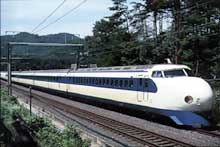|

The 0-series Shinkansen.

Inside the 0-series.
|
The plan to build a high-speed rail link between the
big cities of Tokyo and Osaka started in 1957, when people were
beginning to worry that highways and passenger airline services
would kill off rail travel around the world. In those days, the
fastest trains in Japan were the Tsubame (meaning swallow) and Hato (pigeon) steam locomotives,
whose top speed was just 95 kilometers per hour (59 miles per hour). Back then, the
train trip from Tokyo to Osaka took seven and a half hours. People
decided that it was time to build faster trains that could compete
with cars and planes. The Railway Technical Research Institute,
an organization that studied railways, developed a plan to build
a high-performance train system that would cut the travel time
from Tokyo to Osaka by more than half, to three hours. This new
system was named the Shinkansen, meaning new trunk line.
Under the plan, Shinkansen train tracks would be wider than regular train tracks
and would be built almost alongside existing lines. The Japanese
government approved the plan, and Japan National Railways started
building the Shinkansen in April 1959. Just five and a half years
later, Japan's high-speed railway system was complete. Shinkansen
trains named Hikari (meaning light) and Kodama (echo) started running
along the full 553 kilometers (344 miles) of the Tokaido route connecting
Osaka and Tokyo. The new trains could reach speeds of up to 210
kilometers per hour. When they first started running, Hikari trains
could get from Tokyo to Osaka in just four hours. By 1965, technology
improvements had cut the travel time to three hours and 10 minutes,
making these the fastest trains in the world. The Shinkansen was
nicknamed the "bullet train" in English because of its
bullet-like speed.
Photos: JR Central
|